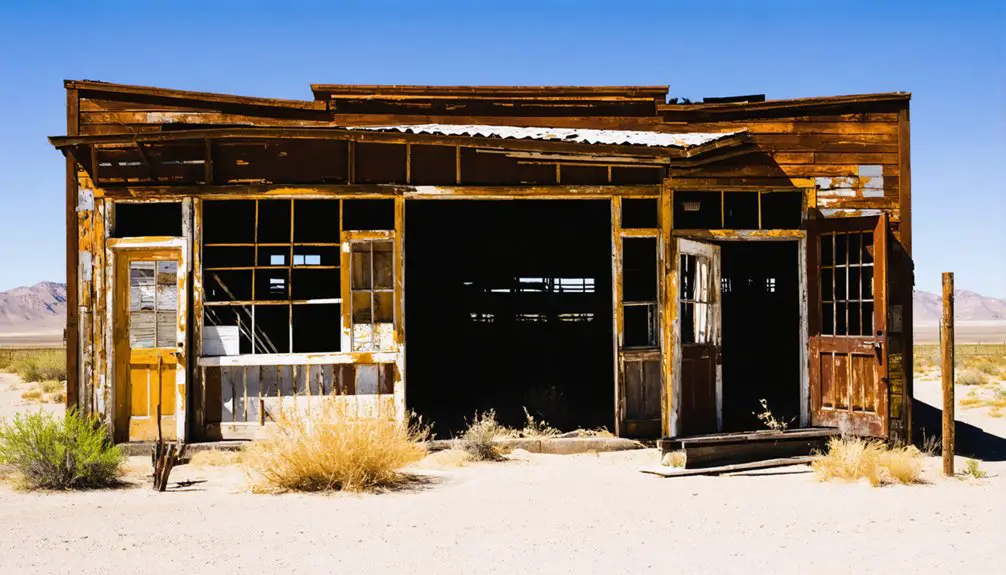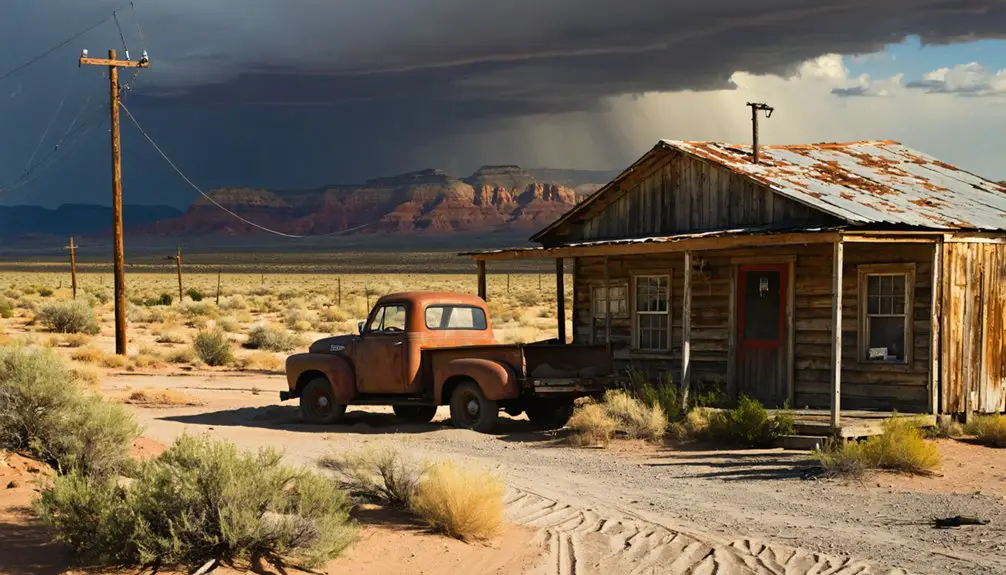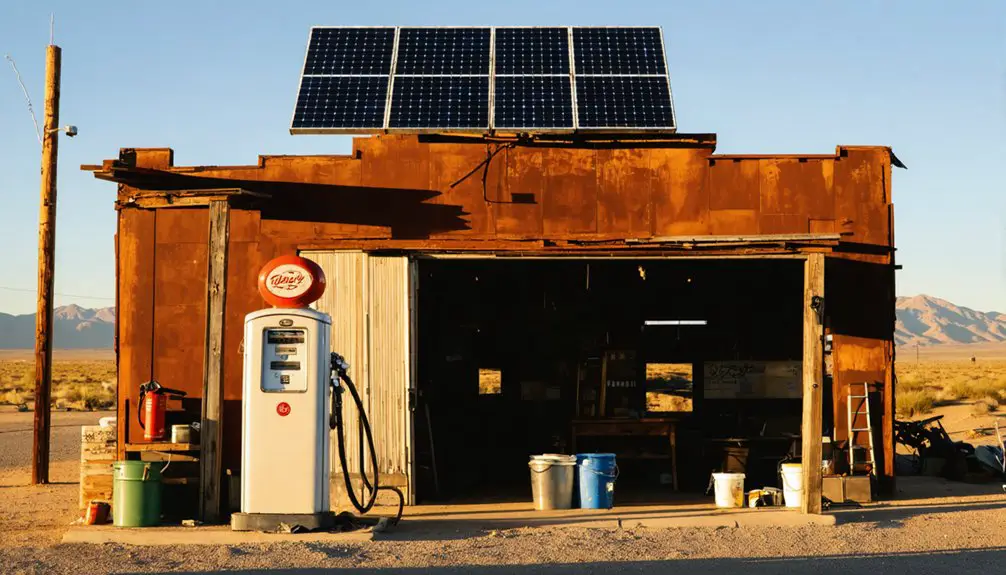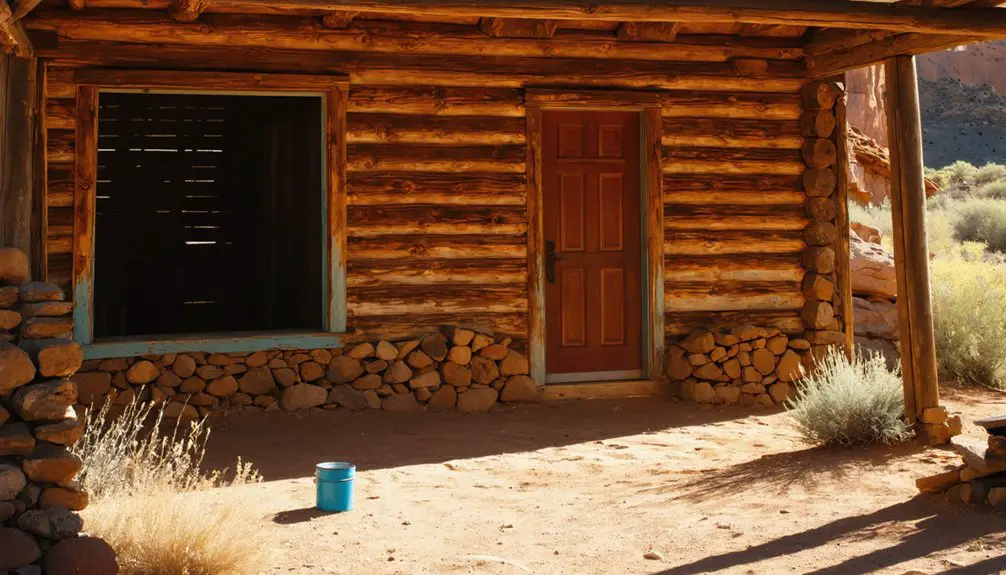You’ll find Cisco, Utah as an evocative ghost town that emerged from an 1880s railroad water stop into a bustling oil boomtown by 1924. The town’s strategic location between Grand Junction and Salt Lake City supported both rail commerce and petroleum production, with its population peaking at 200 in the 1940s. Now abandoned, its weathered buildings, rusted industrial remnants, and graffiti-marked walls tell a compelling story of boom-and-bust in the American West, where modern artists and explorers continue uncovering its layered past.
Key Takeaways
- Cisco, Utah began as a railroad water stop in the 1880s and later boomed during oil discovery in 1924, reaching 200 residents.
- The town’s decline began when diesel engines replaced steam locomotives and worsened when Interstate 70 diverted traffic away.
- Abandoned buildings, including gas stations and restaurants, now stand deteriorated with collapsed roofs and graffiti-covered walls.
- The site features historic railroad infrastructure, including original tracks still used by Union Pacific and remnants from its oil-boom era.
- Recent revival efforts include an artist residency program and Airbnb rentals, though most structures remain in decay.
The Rise of a Railroad Outpost
When the Denver and Rio Grande Railroad expanded into Utah in the early 1880s, Cisco emerged as a significant rail siding along the main line between Grand Junction, Colorado, and Salt Lake City.
This railroad expansion transformed the arid landscape into a crucial transportation hub, where steam locomotives could replenish their water supplies from a dedicated tank and treatment plant.
You’ll find that Cisco’s town development centered around essential railroad infrastructure, including a depot and section buildings.
Since the surrounding desert offered little natural water, the town’s residents relied on water hauled by rail until pipelines from the Colorado River were established.
The railroad’s presence attracted ranchers and businesses, leading to the establishment of general stores, saloons, and housing that served both railroad workers and local inhabitants.
At its peak, Cisco became a major livestock center where over 100,000 sheep were processed annually through its shearing and shipping facilities.
In 1924, the discovery of natural gas and oil in the region brought new economic vitality to the growing settlement.
Golden Era of Oil Discovery
You’ll find Cisco’s transformation into Utah’s premier oil hub began in 1924 when prospectors discovered rich deposits of oil and natural gas at depths between 900-2,000 feet.
The discovery sparked an economic surge that attracted oil workers, businesses, and new residents to the remote railroad stop, swelling the population to 200 by the 1940s. The town originally thrived as a water stop hub for steam locomotives passing through.
The town’s underground wealth came from multiple geological formations, including the Mancos and Dakota sandstones, which produced distinctive light green and black oils that would sustain the region’s economy for decades. Located along the Uncompahgre Uplift, the field represented a significant geological boundary between major basins.
Drilling Sparks Economic Boom
The discovery of oil and natural gas in 1924 transformed Cisco from a modest railroad stop into one of Utah’s most significant petroleum producers. Utah Oil Refining Company’s successful 2,000-foot well in the Cisco Dome field sparked unprecedented economic opportunities, drawing workers to multiple productive zones in the Dakota Sandstone, Mancos, and Cedar Mountain formations.
You’d have witnessed Cisco’s population swell to 200 residents as workforce migration reshaped the landscape. The town’s strategic location along rail and highway routes proved ideal for oil transport, while the 34-35 degree API gravity crude and 1,100 BTU natural gas drove commercial success.
New infrastructure sprouted to support the industry – from fueling stations to restaurants and lodging – creating a bustling hub that served both oil workers and travelers.
Utah’s First Oil Hub
As Utah’s first significant oil hub, Cisco quickly transformed into a bustling petroleum powerhouse after its 1924 discovery.
You’ll find that oil production centered around rich geological formations including the Mancos, Cedar Mountain, and Dakota sandstones, with depths ranging from 900 to 2,000 feet. The area yielded two distinct types of oil: a lighter greenish variety from sandstone and heavier black oil from Pennsylvanian formations.
The economic shift reshaped Cisco’s identity from a simple railroad stop to Utah’s largest oil and natural gas producer. Denver and Rio Grande Western Railroad trains regularly transported oil shipments from the booming town. The 1920s boom period brought unprecedented prosperity and development to the area.
The town’s strategic position along railroad lines proved essential for distribution, while the booming industry attracted workers and businesses.
Multiple reservoirs within the Uncompahgre Uplift, controlled by structural and stratigraphic traps, fueled this remarkable transformation of the American West.
Rich Underground Black Gold
When drillers struck oil near Cisco in 1924, they released a petroleum bonanza from multiple productive zones spanning the Mancos, Cedar Mountain, and Dakota formations. This black gold discovery transformed Utah’s oil exploration landscape, making Cisco the state’s largest producer through the 1940s.
You’ll find varying qualities of crude across the field’s depths of 900 to 2,000 feet.
- Light greenish oils emerged from the Mancos and Dakota sandstones
- Heavier black crude flowed from Saltwash and Brushy Basin zones
- Natural gas yields reached 1,100 BTU
- Oil gravity measured 34-35° API
The field’s success came from its unique geological setting, where structural traps and channel sands created perfect conditions for oil accumulation.
Even today, these underground treasures continue yielding smaller but valuable deposits.
Transportation Evolution’s Impact
Founded as an essential water stop for steam locomotives in the 1880s, Cisco’s destiny became inextricably linked to evolving transportation technologies over the next century.
You’ll find the town’s transformation mirrors the dramatic shifts in American mobility – from steam to diesel locomotives, and from railways to highways.
When diesel engines eliminated the need for frequent water stops in the 1930s, Cisco’s railroad-based economy began its decline. The Denver & Rio Grande Railroad operations at the station became obsolete during this period.
Though you’d see a brief revival during the post-WWII automotive boom, with 24/7 services catering to highway travelers, the construction of Interstate 70 five miles away dealt another blow. The Cisco Disco bar briefly attracted weekend patrons during this period of transition.
These transportation shifts, combined with changing logistics patterns favoring centralized hubs over small railroad towns, transformed Cisco from a bustling community of 200 residents to a ghost town.
Architectural Remnants Today

You’ll find Cisco’s skeletal remains of commercial structures scattered across the desert landscape, with many roofs having succumbed to decades of harsh weather and abandonment.
The town’s original one-room post office stands restored, while other buildings, including several early 20th-century shacks and a mid-1950s gas station, display varying states of decay. A restored 1923 log cabin structure has become an important part of the town’s preserved history. Since 2015, Eileen Muza has worked to renovate and transform these historic structures into livable spaces.
Railroad infrastructure ruins dot the area, serving as stark reminders of Cisco’s origins as a bustling rail stop that once supported the region’s oil production industry.
Collapsing Commercial Buildings
The architectural remnants of Cisco’s commercial district paint a stark portrait of abandonment and decay, with most buildings now reduced to dilapidated shells of wood and corrugated metal.
You’ll find widespread building deterioration throughout the site, with only rare exceptions like the former general store still standing. The harsh desert climate and decades of neglect have transformed once-bustling businesses into hazardous ruins, creating significant preservation challenges.
- Collapsed roofs and unstable structures dominate the landscape, scattered across a disorganized debris field.
- Former gas stations and restaurants, once the town’s last surviving businesses, now weather away under relentless sun.
- Vandalism and graffiti mark the remaining walls, while broken glass and rusted metal litter the ground.
- Evidence of early 20th-century craftsmanship peeks through the decay, though most features are weathered beyond recognition.
Railroad Infrastructure Ruins
Remnants of Cisco’s railroad heritage endure through deteriorating infrastructure that once served the Denver and Rio Grande Western Railroad.
You’ll find the original railbed and tracks still in use by Union Pacific, alongside rusting railroad relics scattered throughout this ghost town. The water tower’s foundations and partial walls stand as silent witnesses to the steam engine era, while deteriorated section houses reveal where railroad workers once lived.
Near the tracks, you’ll spot aging industrial artifacts from both rail operations and the 1924 oil boom.
The rail corridor remains the town’s defining feature, with abandoned loading areas and sidings telling stories of bustling commerce. Early 20th-century construction methods are evident in the track architecture, though decades of neglect have left their mark through vandalism and decay.
Hollywood’s Desert Canvas
Since its early days, Hollywood has transformed Utah’s desert landscape into an iconic canvas for Western films, creating enduring imagery that shaped American cultural mythology.
You’ll find that cinematic landscapes like Cisco’s stark terrain perfectly embody the visual language that defined classic Westerns, offering rich desert symbolism of freedom and isolation. The desert’s unique geological features and lighting conditions provided filmmakers with a distinctive palette that broke from European traditions.
- Native American cultural elements wove authentically into Western film narratives
- Post-war artistic movements influenced abstract desert representations
- Pop artists like Ed Ruscha incorporated desert commercial imagery into their work
- The landscape served as a powerful backdrop for exploring frontier themes and identity
Modern Tourism and Photography

Modern photographers and tourists have transformed Cisco’s haunted terrain from a Hollywood backdrop into a compelling destination for urban exploration and artistic documentation.
You’ll find visitors capturing everything from deteriorating interiors with broken organs to dramatic desert sunsets through their lenses, while drones sweep overhead to reveal the town’s scattered remnants against the vast landscape.
Tourist photography has sparked both creativity and controversy, with local requests to shoot only from roads to protect private property and ongoing restoration work.
While you can explore the site freely, you’ll notice signs and fences guiding you away from sensitive areas.
The few available Airbnb rentals offer an immersive experience, though amenities remain sparse – preserving the raw, uncommercial atmosphere that draws urban explorers and photographers to this desert time capsule.
Desert Climate’s Influence
The harsh desert climate has shaped every aspect of Cisco’s existence, from its crumbling infrastructure to its sparse vegetation.
You’ll find extreme temperature swings, with scorching 72°F+ summers and frigid 35°F winters, making climate adaptation strategies essential for survival. The area’s scant 9.74 inches of annual precipitation creates an unforgiving environment where only the hardiest plants demonstrate vegetation resilience.
- Mancos Shale soil turns sticky when wet and shrinks when dry, wreaking havoc on buildings
- Constant winds accelerate structural decay and spread debris throughout the ghost town
- Flash floods from sudden downpours carve deep gullies in the desert landscape
- Greasewood stands as one of few plants tough enough to survive the selenium-rich, alkaline soil
The environment’s hostility continues to challenge any attempts at preserving Cisco’s remaining structures.
Recent Revival Efforts

Despite the harsh desert conditions, new life has emerged in Cisco through recent revival efforts.
You’ll find the town’s transformation began with Eileen Muza, who established the Home of the Brave artist residency and spent years renovating abandoned structures using salvaged materials. She created unique spaces including an Airbnb shed, a skatepark, and converted vehicles into artist dwellings.
In December 2024, Kara Bard took over the property, planning to relaunch the artist residency in fall 2025.
The revival hasn’t been without challenges – from vandalism to local conflicts – yet the creative community persists.
You’ll see evidence of artistic expression throughout, from murals to sculptural installations, though many buildings still await restoration.
This ghost town’s rebirth exemplifies how community revitalization can thrive through artistic vision and determination.
Frequently Asked Questions
Is It Legal to Enter and Explore the Abandoned Buildings in Cisco?
You can’t legally enter these buildings – they’re private property with posted “No Trespassing” signs. Urban exploration here violates historical preservation efforts and property rights, risking fines and prosecution.
Are There Any Reported Paranormal Activities or Ghost Sightings in Cisco?
Standing amid weathered walls and rusted relics, you won’t find documented ghost encounters or haunted history here. Despite the eerie atmosphere, there aren’t any credible reports of paranormal activity.
What’s the Closest Town With Accommodations for Visitors to Cisco?
Thompson Springs is your closest spot for nearby lodging, just 5 miles north. For more visitor amenities, you’ll find Green River 40 miles west and Moab 50 miles southwest.
Can Metal Detecting or Artifact Collecting Be Done in Cisco?
You can’t legally metal detect or collect artifacts since it’s private property. Current regulations protect artifact preservation, so you’ll need explicit owner permission and must follow Utah’s historical preservation laws.
Are There Guided Tours Available of the Ghost Town?
Presently, you won’t find professional guided exploration or tour operators at this location. You’ll need to explore independently, being mindful of private property, safety hazards, and unstable structures throughout the site.
References
- https://www.legendsofamerica.com/ut-cisco/
- https://www.onlyinyourstate.com/experiences/utah/cisco-ut
- https://roadtrippers.com/magazine/cisco-ghost-town-utah/
- https://www.rmpbs.org/blogs/rocky-mountain-pbs/memories-of-a-ghost-town
- https://www.americansouthwest.net/utah/cisco/index.html
- http://www.gribblenation.org/2018/04/ghost-town-tuesday-cisco-ut-and-old-us.html
- https://moabsunnews.com/2021/11/04/the-story-of-cisco-the-rise-fall-and-rise-again-of-a-small-utah-town/
- https://www.canyoncountryzephyr.com/2018/08/01/a-history-of-cisco-utah-by-herm-hoops/
- https://en.wikipedia.org/wiki/Cisco_Oil_Field
- https://gotaltitudesite.wordpress.com/2018/03/20/cisco-utah/



